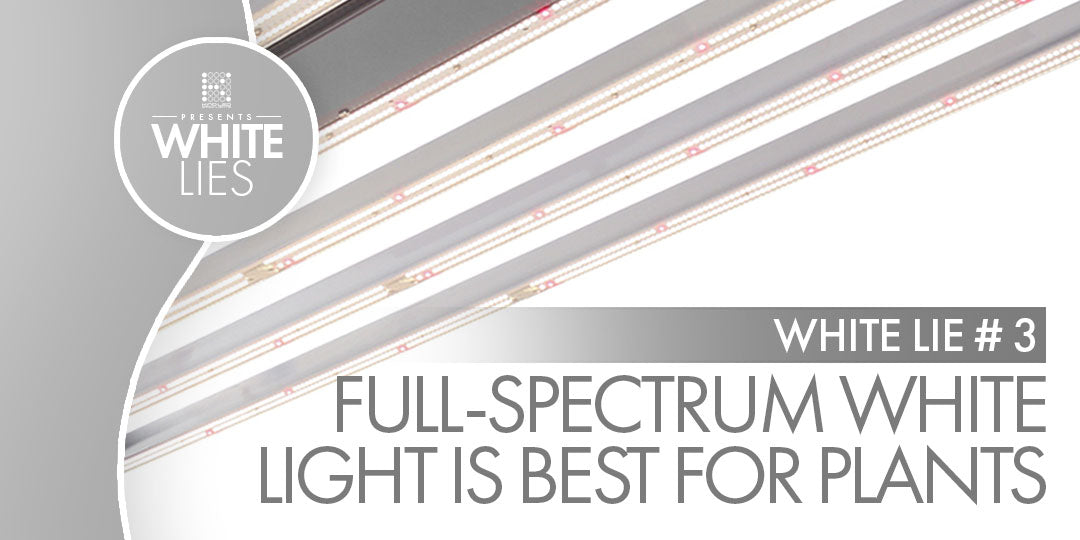White Lie #3: Full-Spectrum white light is the best for your plants

Welcome to a new blog series from Kind LED Grow Lights where we address some of the misinformation currently being spread by the white light LED manufacturers so prolific in the horticultural lighting industry. If you haven’t yet had the opportunity, please read our first and second posts in this series.
- White Lie #1: Efficacy is more important than PPFD
- White Lie #2: Efficacy is the single most important aspect of an LED Grow Light
White Lie #3: Full-Spectrum white light is the best for your plants
The term full-spectrum was used in the 1960s by photobiologist Dr. John Ott to describe electric light sources that simulate the visible and ultraviolet (UV) spectrum of natural light (source). Full-Spectrum lighting technically means that a light covers all wavelengths of the electromagnetic spectrum that are helpful to plants. However, the ratio of these wavelengths can differ widely between fixtures. One thing that all full-spectrum LED grow lights have in common is that they all tend to mimic the look of natural light.
As we discussed last week, white light LED manufacturers use readily available white diodes manufactured for countless uses in every imaginable industry. To mimic the look of natural light, full-spectrum LED grow lights include a large amount of green and yellow light. While these spectrums play a vital role in plant development, they are effective in considerably smaller amounts than red and blue light. The amount produced by white light LED manufacturers far exceeds the amount a plant can actually absorb, and more than 50% of that light winds up reflected from the plant’s surface. That wasted energy gets turned into heat, raising the temperature of the grow environment. This heat can have a detrimental effect on plants, even potentially damaging trichome production, and also forces the grower to invest money in additional cooling equipment and increase their watering schedules.
Full-Spectrum grow lights manufacturers like to claim that they are replicating the spectrum of the sun. While we can’t argue that the sun does a pretty fantastic job of growing plants outdoors—one need only to look outside to see that it seems to handle the job pretty well—it’s a gigantic ball of endless nuclear energy that one wouldn’t necessarily want to bring inside their commercial grow facility. For one thing, the sun doesn’t have to worry about utility bills. So replicating natural light has the unfortunate side-effect of including quite a bit of the visible spectrum which simply cannot be absorbed by plants, and winds up simply being wasted—having a negative effect both on the grow environment and the grower’s pocketbook.
Targeted-spectrum LED grow lights limit the amount of yellow and green light a fixture emits, which decreases the amount of energy wasted by the fixture, and consequently, the amount of heat produced. This, in turn, reduces the need for additional cooling measures needed in your grow environment and can lower utility bills significantly.
Since the primary focus of targeted-spectrum LED grow lights is on the blue and red parts of the visible spectrum, the light produced looks purple, or even pink. Because of this, some growers have started to refer to these fixtures as “blurple” LED grow lights. While white-light LED manufacturers have long used this difference in appearance as validation that full-spectrum fixtures are ideal for grow environments, it’s important to remember that LED grow lights exist for the benefit of plants, not people. White-light LEDs may be easier to manufacture and photograph better, but these are human conveniences. A targeted spectrum is much more beneficial to plants, and ultimately, that is what matters for growers everywhere, from home growers to commercial cultivation facilities.




